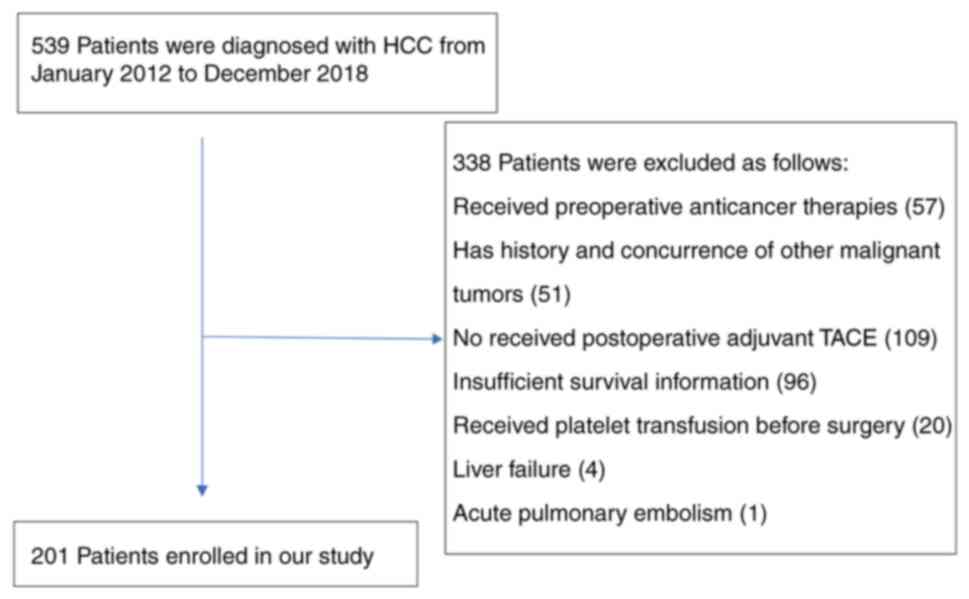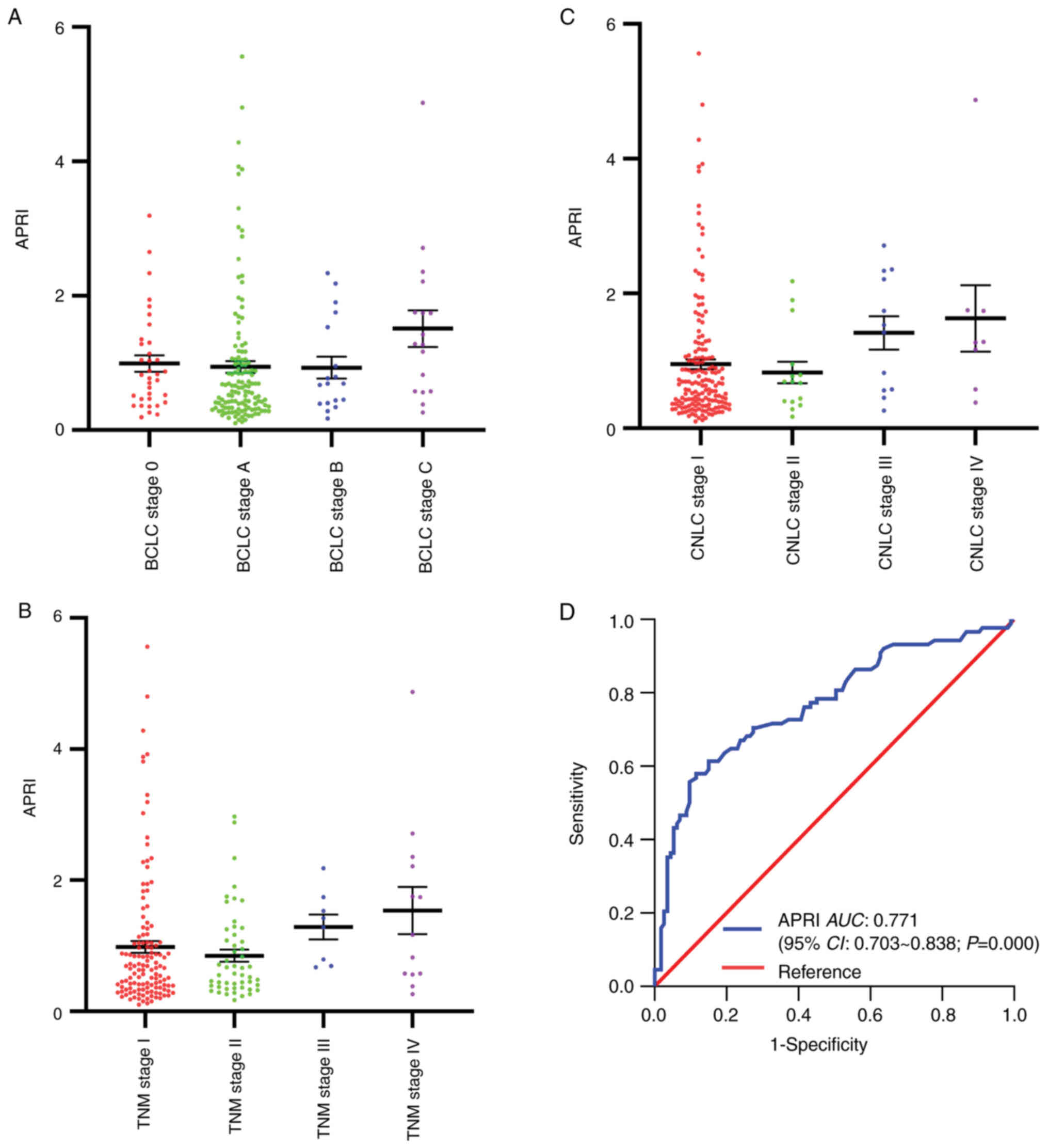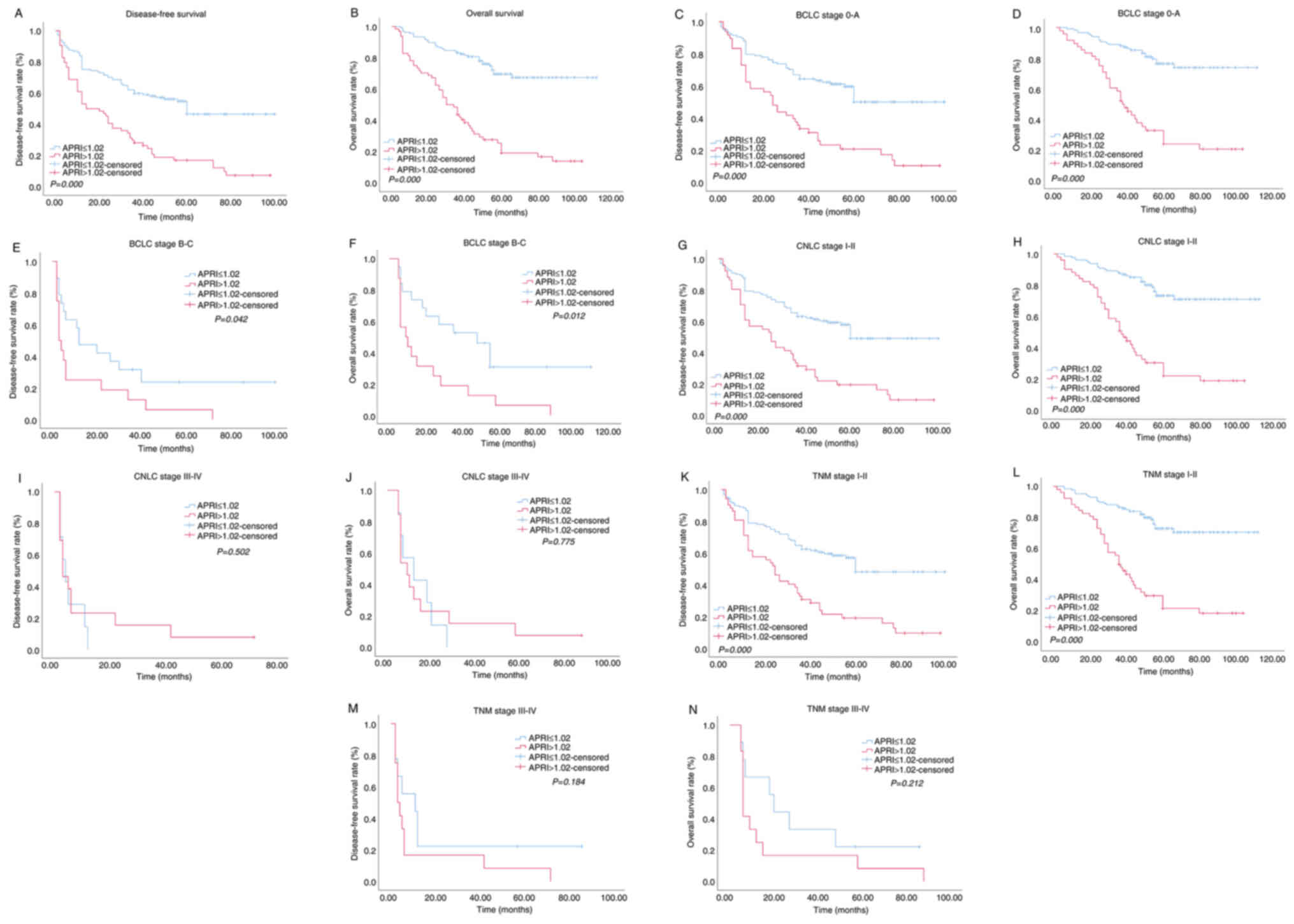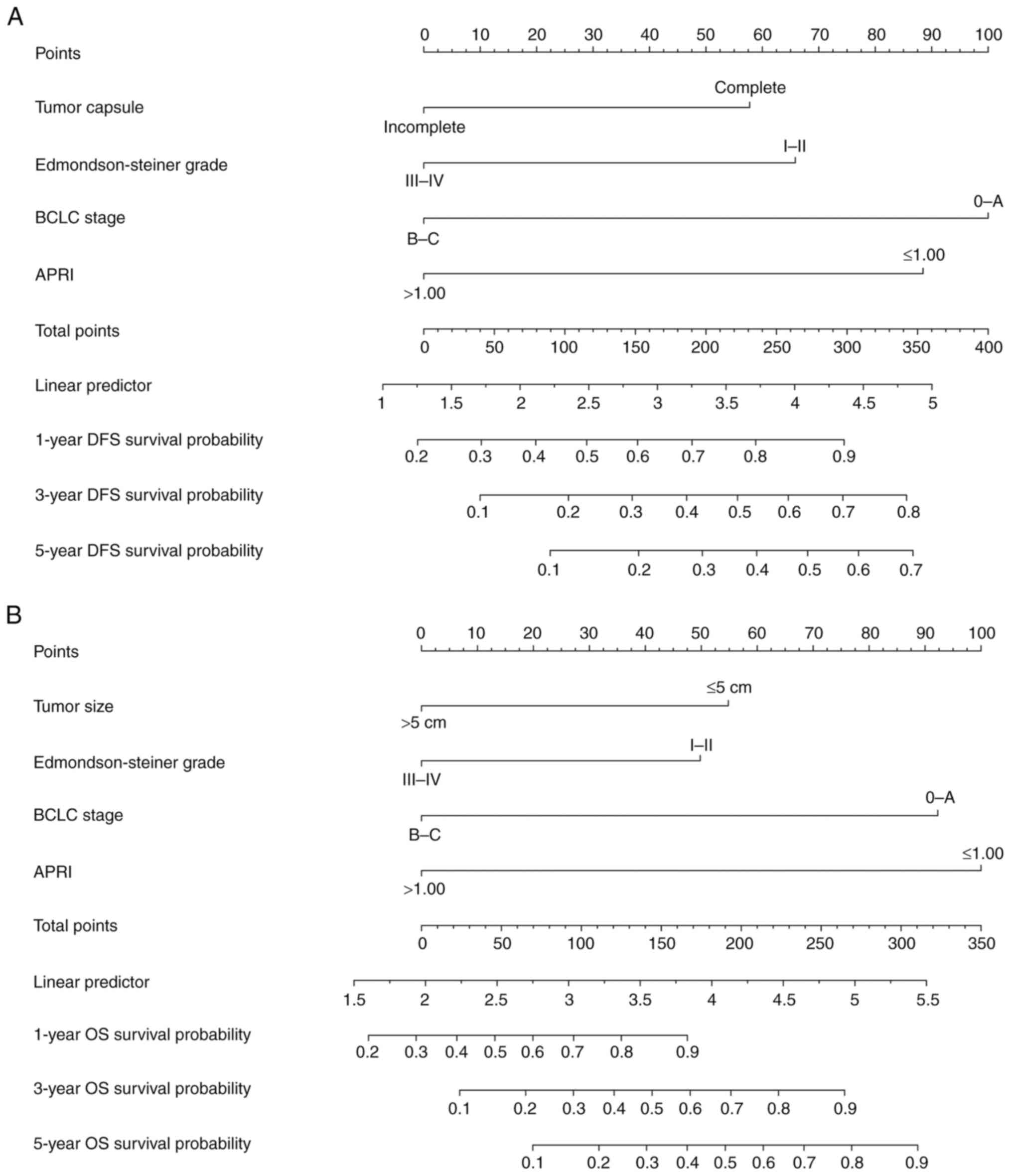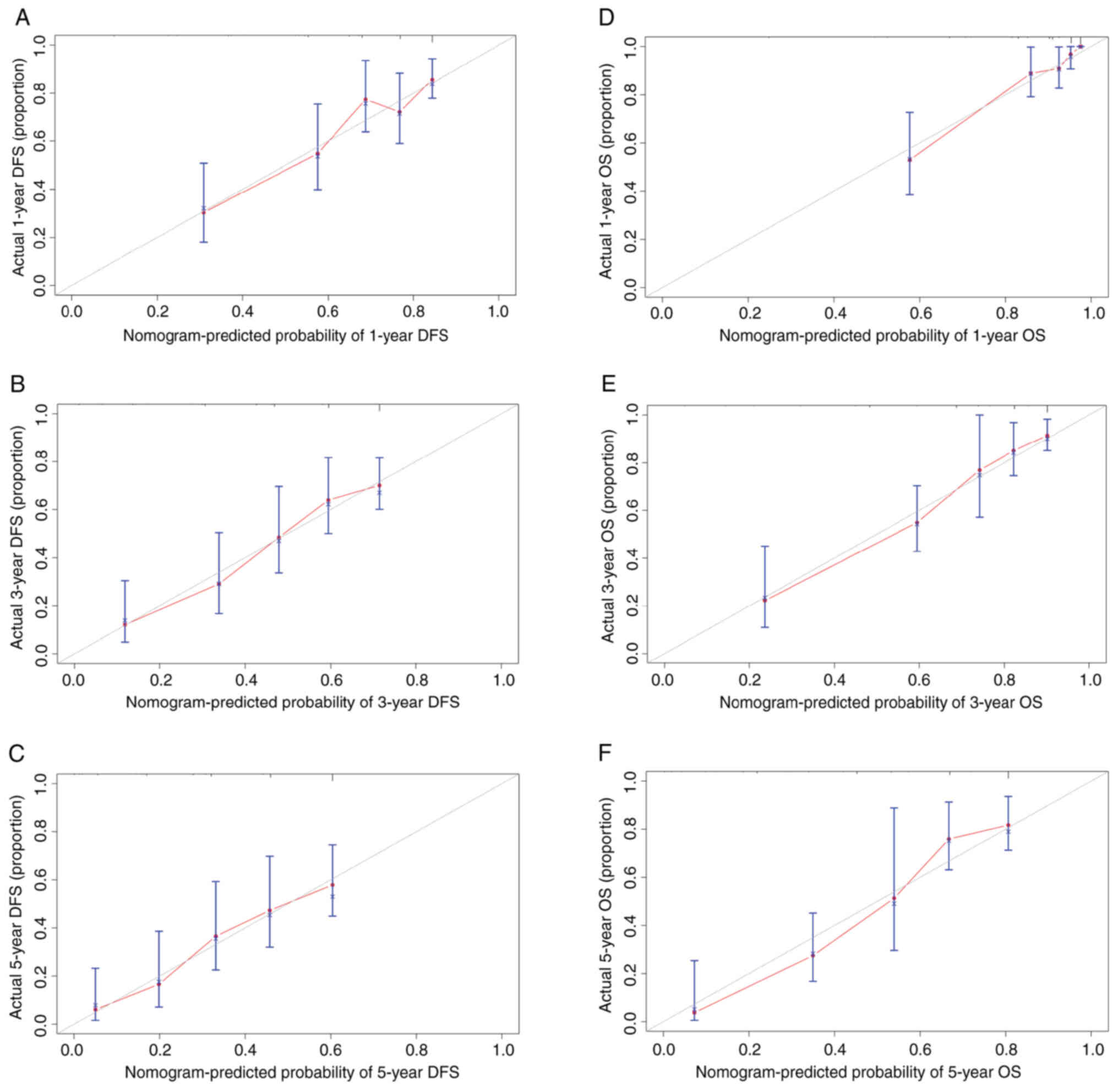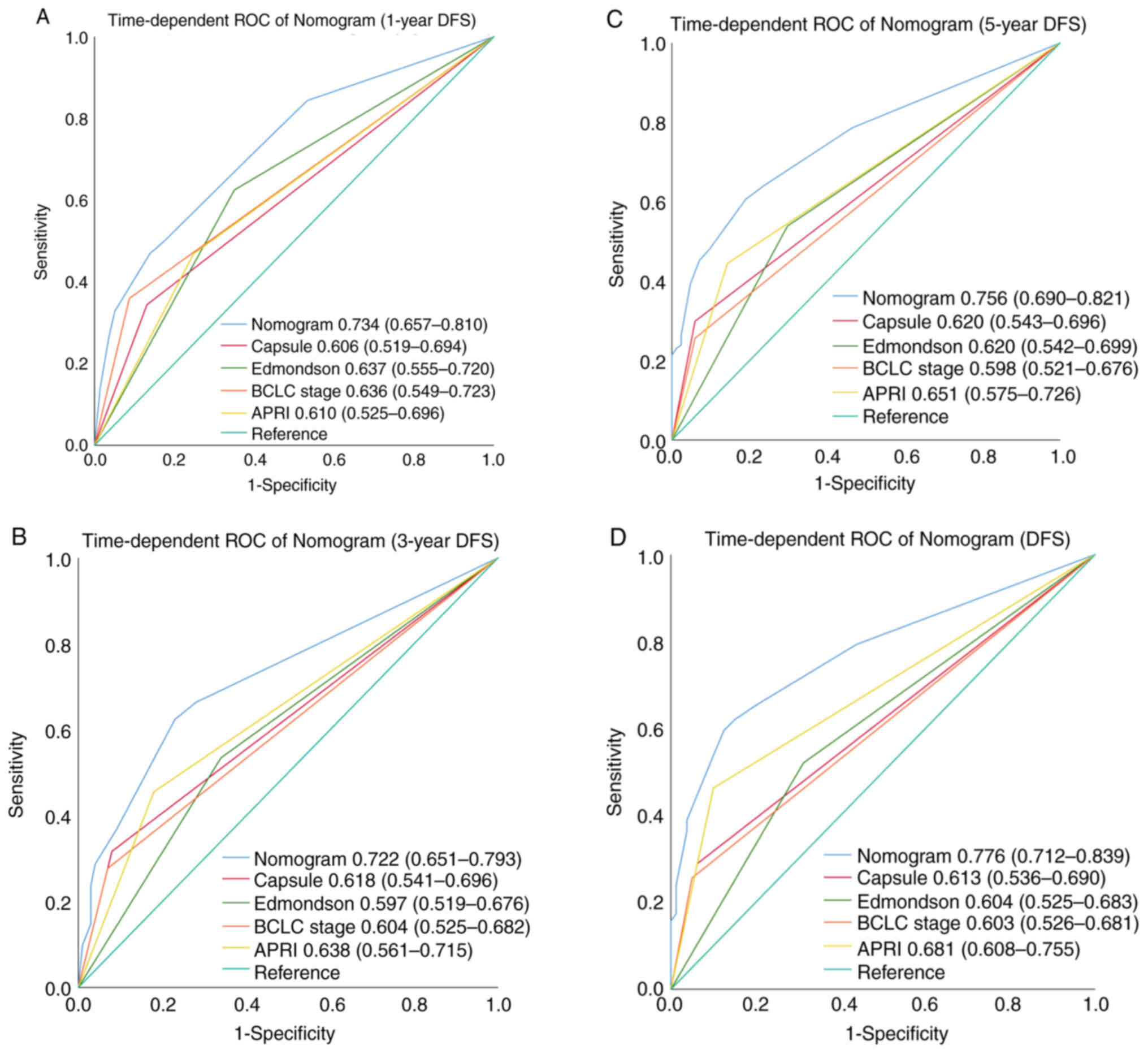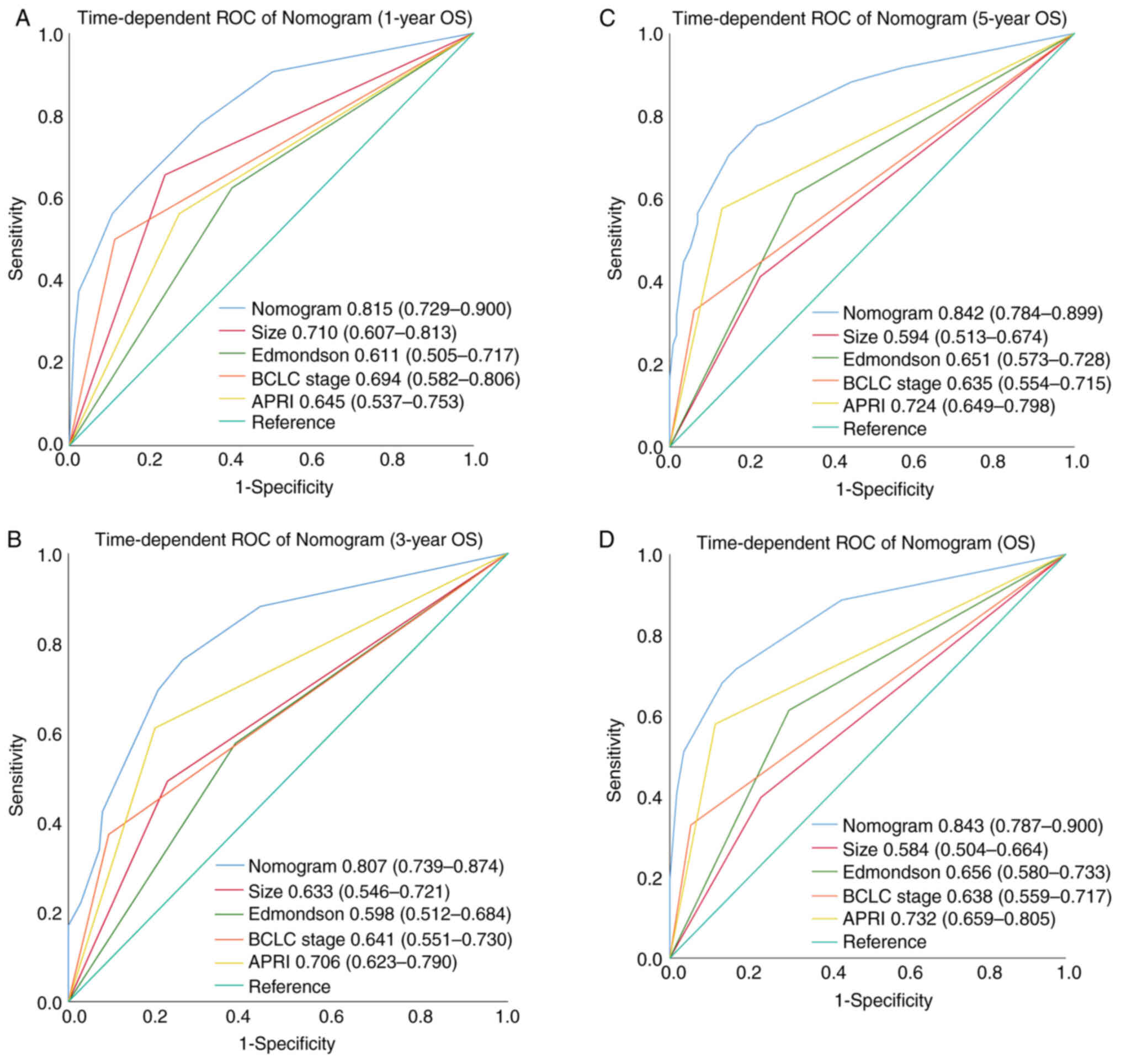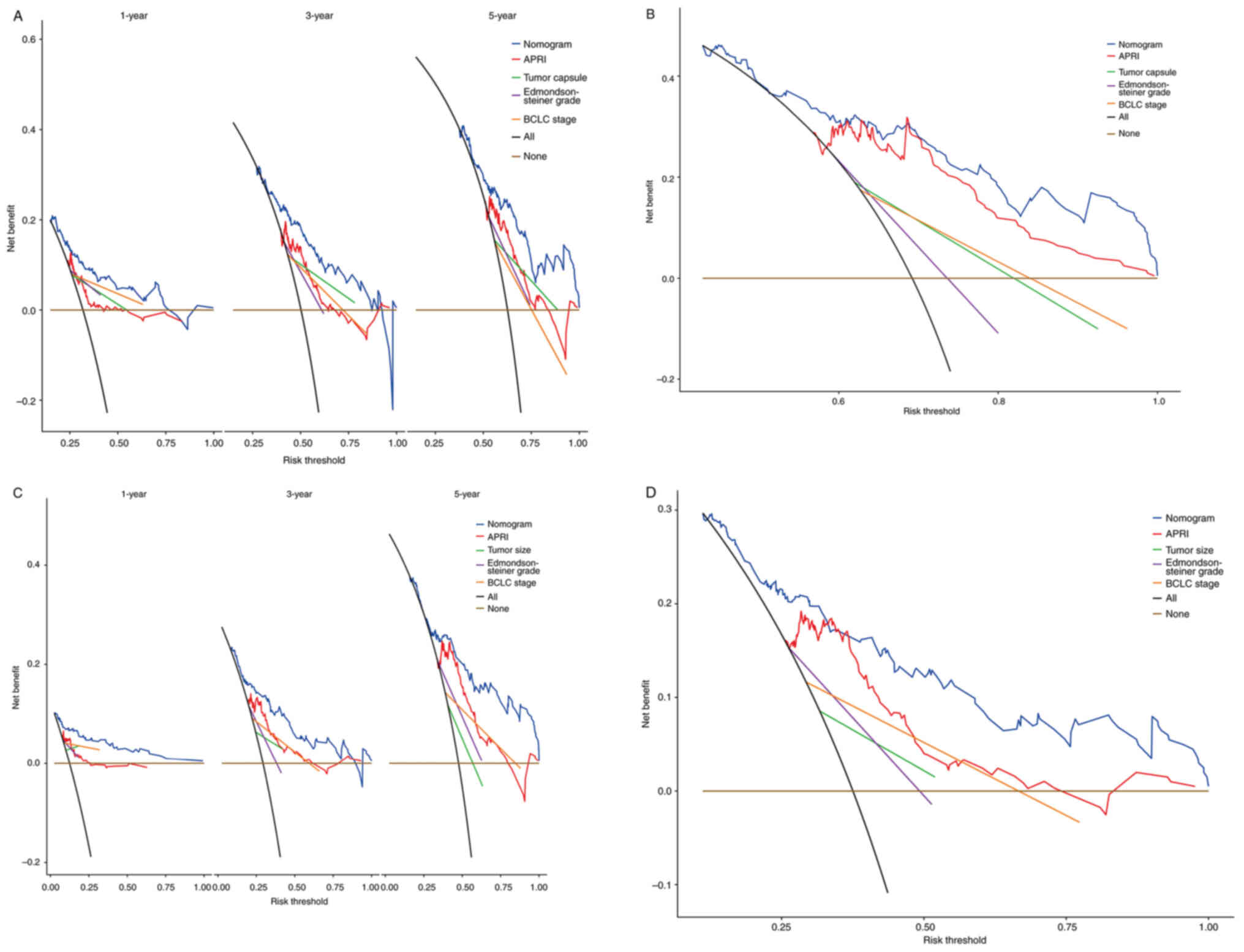|
1
|
Chen W, Zheng R, Baade PD, Zhang S, Zeng
H, Bray F, Jemal A, Yu XQ and He J: Cancer statistics in China,
2015. CA Cancer J Clin. 66:115–132. 2016. View Article : Google Scholar : PubMed/NCBI
|
|
2
|
Zhou M, Wang H, Zeng X, Yin P, Zhu J, Chen
W, Li X, Wang L, Wang L, Liu Y, et al: Mortality, morbidity, and
risk factors in China and its provinces, 1990–2017: A systematic
analysis for the Global Burden of Disease Study 2017. Lancet.
394:1145–1158. 2019. View Article : Google Scholar : PubMed/NCBI
|
|
3
|
Bray F, Ferlay J, Soerjomataram I, Siegel
RL, Torre LA and Jemal A: Global cancer statistics 2018: GLOBOCAN
estimates of incidence and mortality worldwide for 36 cancers in
185 countries. CA Cancer J Clin. 68:394–424. 2018. View Article : Google Scholar : PubMed/NCBI
|
|
4
|
Llovet JM, Villanueva A, Marrero JA,
Schwartz M, Meyer T, Galle PR, Lencioni R, Greten TF, Kudo M,
Mandrekar SJ, et al: Trial design and endpoints in hepatocellular
carcinoma: AASLD Consensus Conference. Hepatology. 73 (Suppl
1):S158–S191. 2021. View Article : Google Scholar
|
|
5
|
Cescon M, Vetrone G, Grazi GL, Ramacciato
G, Ercolani G, Ravaioli M, Del GM and Pinna AD: Trends in
perioperative outcome after hepatic resection: Analysis of 1500
consecutive unselected cases over 20 years. Ann Surg. 249:995–1002.
2009. View Article : Google Scholar : PubMed/NCBI
|
|
6
|
Bruix J and Sherman M: Management of
hepatocellular carcinoma: An update. Hepatology. 53:1020–1022.
2011. View Article : Google Scholar : PubMed/NCBI
|
|
7
|
Forner A, Gilabert M, Bruix J and Raoul
JL: Treatment of intermediate-stage hepatocellular carcinoma. Nat
Rev Clin Oncol. 11:525–535. 2014. View Article : Google Scholar : PubMed/NCBI
|
|
8
|
Tournoux C, Paoletti X and Barbare JC:
Treatment outcomes for hepatocellular carcinoma using
chemoembolization in combination with other therapies. Cancer Treat
Rev. 33:762–763. 2007. View Article : Google Scholar : PubMed/NCBI
|
|
9
|
Lau WY, Lai EC, Leung TW and Yu SC:
Adjuvant intra-arterial iodine-131-labeled lipiodol for resectable
hepatocellular carcinoma: A prospective randomized trial-update on
5-year and 10-year survival. Ann Surg. 247:43–48. 2008. View Article : Google Scholar : PubMed/NCBI
|
|
10
|
Jiang JH, Guo Z, Lu HF, Wang XB, Yang HJ,
Yang FQ, Bao SY, Zhong JH, Li LQ, Yang RR and Xiang BD: Adjuvant
transarterial chemoembolization after curative resection of
hepatocellular carcinoma: Propensity score analysis. World J
Gastroenterol. 21:4627–4634. 2015. View Article : Google Scholar : PubMed/NCBI
|
|
11
|
Paik KY and Kim EK: Pathologic response to
preoperative transarterial chemoembolization for resectable
hepatocellular carcinoma may not predict recurrence after liver
resection. Hepatobiliary Pancreat Dis Int. 15:158–164. 2016.
View Article : Google Scholar : PubMed/NCBI
|
|
12
|
Wang Z, Ren Z, Chen Y, Hu J, Yang G, Yu L,
Yang X, Huang A, Zhang X, Zhou S, et al: Adjuvant transarterial
chemoembolization for HBV-related hepatocellular carcinoma after
resection: A randomized controlled study. Clin Cancer Res.
24:2074–2081. 2018. View Article : Google Scholar : PubMed/NCBI
|
|
13
|
Bruix J, Qin S, Merle P, Granito A, Huang
YH, Bodoky G, Pracht M, Yokosuka O, Rosmorduc O, Breder V, et al:
Regorafenib for patients with hepatocellular carcinoma who
progressed on sorafenib treatment (RESORCE): A randomised,
double-blind, placebo-controlled, phase 3 trial. Lancet. 389:56–66.
2017. View Article : Google Scholar : PubMed/NCBI
|
|
14
|
Tsurusaki M and Murakami T: Surgical and
Locoregional therapy of HCC: TACE. Liver Cancer. 4:165–175. 2015.
View Article : Google Scholar : PubMed/NCBI
|
|
15
|
Wu CY, Lin JT, Ho HJ, Su CW, Lee TY, Wang
SY, Wu C and Wu JC: Association of nucleos(t)ide analogue therapy
with reduced risk of hepatocellular carcinoma in patients with
chronic hepatitis B: A nationwide cohort study. Gastroenterology.
147:143–151. 2014. View Article : Google Scholar : PubMed/NCBI
|
|
16
|
Hann HW, Wan S, Lai Y, Hann RS, Myers RE,
Patel F, Zhang K, Ye Z, Wang C and Yang H: Aspartate
aminotransferase to platelet ratio index as a prospective predictor
of hepatocellular carcinoma risk in patients with chronic hepatitis
B virus infection. J Gastroenterol Hepatol. 30:131–138. 2015.
View Article : Google Scholar : PubMed/NCBI
|
|
17
|
Su CW, Chau GY, Hung HH, Yeh YC, Lei HJ,
Hsia CY, Lai CR, Lin HC and Wu JC: Impact of Steatosis on prognosis
of patients with early-stage hepatocellular carcinoma after hepatic
resection. Ann Surg Oncol. 22:2253–2261. 2015. View Article : Google Scholar : PubMed/NCBI
|
|
18
|
Sitia G, Aiolfi R, Di Lucia P, Mainetti M,
Fiocchi A, Mingozzi F, Esposito A, Ruggeri ZM, Chisari FV,
Iannacone M and Guidotti LG: Antiplatelet therapy prevents
hepatocellular carcinoma and improves survival in a mouse model of
chronic hepatitis B. Proc Natl Acad Sci USA. 109:E2165–E2172. 2012.
View Article : Google Scholar : PubMed/NCBI
|
|
19
|
Hwang SJ, Luo JC, Li CP, Chu CW, Wu JC,
Lai CR, Chiang JH, Chau GY, Lui WY, Lee CC, et al: Thrombocytosis:
A paraneoplastic syndrome in patients with hepatocellular
carcinoma. World J Gastroenterol. 10:2472–2477. 2004. View Article : Google Scholar : PubMed/NCBI
|
|
20
|
Ichikawa T, Uenishi T, Takemura S, Oba K,
Ogawa M, Kodai S, Shinkawa H, Tanaka H, Yamamoto T, Tanaka S, et
al: A simple, noninvasively determined index predicting hepatic
failure following liver resection for hepatocellular carcinoma. J
Hepatobiliary Pancreat Surg. 16:42–48. 2009. View Article : Google Scholar : PubMed/NCBI
|
|
21
|
Amano H, Tashiro H, Oshita A, Kobayashi T,
Tanimoto Y, Kuroda S, Tazawa H, Itamoto T, Asahara T and Ohdan H:
Significance of platelet count in the outcomes of hepatectomized
patients with hepatocellular carcinoma exceeding the Milan
criteria. J Gastrointest Surg. 15:1173–1181. 2011. View Article : Google Scholar : PubMed/NCBI
|
|
22
|
Maithel SK, Kneuertz PJ, Kooby DA,
Scoggins CR, Weber SM, Martin RC II, Mcmasters KM, Cho CS, Winslow
ER, Wood WC and Staley CA III: Importance of low preoperative
platelet count in selecting patients for resection of
hepatocellular carcinoma: A multi-institutional analysis. J Am Coll
Surg. 212:638–650. 2011. View Article : Google Scholar : PubMed/NCBI
|
|
23
|
Hwang SG, Kim KM, Cheong JH, Kim HI, An
JY, Hyung WJ and Noh SH: Impact of pretreatment thrombocytosis on
blood-borne metastasis and prognosis of gastric cancer. Eur J Surg
Oncol. 38:562–567. 2012. View Article : Google Scholar : PubMed/NCBI
|
|
24
|
Kurt M, Onal IK, Sayilir AY, Beyazit Y,
Oztas E, Kekilli M, Turhan N, Karaman K and Akdogan M: The role of
mean platelet volume in the diagnosis of hepatocellular carcinoma
in patients with chronic liver disease. Hepatogastroenterology.
59:1580–1582. 2012.PubMed/NCBI
|
|
25
|
Murray KF and Carithers RJ: AASLD practice
guidelines: Evaluation of the patient for liver transplantation.
Hepatology. 41:1407–1432. 2005. View Article : Google Scholar : PubMed/NCBI
|
|
26
|
Shen SL, Fu SJ, Chen B, Kuang M, Li SQ,
Hua YP, Liang LJ, Guo P, Hao Y and Peng BG: Preoperative aspartate
aminotransferase to platelet ratio is an independent prognostic
factor for hepatitis B-induced hepatocellular carcinoma after
hepatic resection. Ann Surg Oncol. 21:3802–3809. 2014. View Article : Google Scholar : PubMed/NCBI
|
|
27
|
Zhang C, Wu J, Xu J, Xu J, Xian J, Xue S
and Ye J: Association between aspartate
Aminotransferase-to-Platelet ratio index and hepatocellular
carcinoma risk in patients with chronic hepatitis: A meta-analysis
of cohort study. Dis Markers. 2019:20468252019. View Article : Google Scholar : PubMed/NCBI
|
|
28
|
Amin MB, Greene FL, Edge SB, Compton CC,
Gershenwald JE, Brookland RK, Meyer L, Gress DM, Byrd DR and
Winchester DP: The Eighth edition AJCC Cancer Staging Manual:
Continuing to build a bridge from a population-based to a more
‘personalized’ approach to cancer staging. CA Cancer J Clin.
67:93–99. 2017. View Article : Google Scholar : PubMed/NCBI
|
|
29
|
Okuda K, Ohtsuki T, Obata H, Tomimatsu M,
Okazaki N, Hasegawa H, Nakajima Y and Ohnishi K: Natural history of
hepatocellular carcinoma and prognosis in relation to treatment.
Study of 850 patients. Cancer. 56:918–928. 1985. View Article : Google Scholar : PubMed/NCBI
|
|
30
|
Llovet JM, Bru C and Bruix J: Prognosis of
hepatocellular carcinoma: The BCLC staging classification. Semin
Liver Dis. 19:329–338. 1999. View Article : Google Scholar : PubMed/NCBI
|
|
31
|
Kudo M, Chung H, Haji S, Osaki Y, Oka H,
Seki T, Kasugai H, Sasaki Y and Matsunaga T: Validation of a new
prognostic staging system for hepatocellular carcinoma: The JIS
score compared with the CLIP score. Hepatology. 40:1396–1405. 2004.
View Article : Google Scholar : PubMed/NCBI
|
|
32
|
Llovet JM and Bruix J: Prospective
validation of the Cancer of the Liver Italian Program (CLIP) score:
A new prognostic system for patients with cirrhosis and
hepatocellular carcinoma. Hepatology. 32:679–680. 2000. View Article : Google Scholar : PubMed/NCBI
|
|
33
|
Kim JY, Sinn DH, Gwak GY, Choi GS, Saleh
AM, Joh JW, Cho SK, Shin SW, Carriere KC, Ahn JH, et al:
Transarterial chemoembolization versus resection for
intermediate-stage (BCLC B) hepatocellular carcinoma. Clin Mol
Hepatol. 22:250–258. 2016. View Article : Google Scholar : PubMed/NCBI
|
|
34
|
Selby LK, Tay RX, Woon WW, Low JK, Bei W,
Shelat VG, Pang TC and Junnarkar SP: Validity of the Barcelona
clinic liver cancer and Hong Kong liver cancer staging systems for
hepatocellular carcinoma in Singapore. J Hepatobiliary Pancreat
Sci. 24:143–152. 2017. View Article : Google Scholar : PubMed/NCBI
|
|
35
|
Wai CT, Greenson JK, Fontana RJ,
Kalbfleisch JD, Marrero JA, Conjeevaram HS and Lok AS: A simple
noninvasive index can predict both significant fibrosis and
cirrhosis in patients with chronic hepatitis C. Hepatology.
38:518–526. 2003. View Article : Google Scholar : PubMed/NCBI
|
|
36
|
Zhu GQ, Wang K, Wang B, Zhou YJ, Yang Y,
Chen EB, Zhou ZJ, Zhou SL, Shi YH, Zhou J and Dai Z: Aspartate
aminotransferase-to-platelet ratio index predicts prognosis of
hepatocellular carcinoma after postoperative adjuvant transarterial
chemoembolization. Cancer Manag Res. 11:63–79. 2019. View Article : Google Scholar : PubMed/NCBI
|
|
37
|
Zhang Y, Wan G, Li H, Gao L, Liu N, Gao P,
Liu Y, Gao X and Duan X: A prediction nomogram for hepatitis B
virus-associated hepatocellular carcinoma. Scand J Gastroenterol.
1–8. 2023.doi: 10.1080/00365521.2023.2252546 (Epub ahead of print).
View Article : Google Scholar
|
|
38
|
Tang T, Qiu JL, Li GW, Huang MP, Li Y, Li
YJ and Gu SZ: Aspartate aminotransferase-to-platelet ratio predicts
response to transarterial chemoembolisation and prognosis in
hepatocellular carcinoma patients. Clin Radiol. 73:259–265. 2018.
View Article : Google Scholar : PubMed/NCBI
|
|
39
|
Zhang X, Svn Z, Liv M, Liu M, Zhang Y and
Sun Q: Assessment of prognostic value of aspartate
Aminotransferase-to-Platelet ratio index in patients with
hepatocellular carcinoma: Meta-analysis of 28 cohort studies. Front
Med (Lausanne). 8:7562102021. View Article : Google Scholar : PubMed/NCBI
|
|
40
|
Hung HH, Su CW, Lai CR, Chau GY, Chan CC,
Huang YH, Huo TI, Lee PC, Kao WY, Lee SD and Wu JC: Fibrosis and
AST to platelet ratio index predict post-operative prognosis for
solitary small hepatitis B-related hepatocellular carcinoma.
Hepatol Int. 4:691–699. 2010. View Article : Google Scholar : PubMed/NCBI
|
|
41
|
Zhang X, Xin Y, Yang Y, Chen Y, Cao XJ,
Wang Y, Fan Q, Zhou X and Li X: Aspartate
Aminotransferase-to-Platelet ratio index for predicting late
recurrence of hepatocellular carcinoma after radiofrequency
ablation. Int J Hyperthermia. 39:437–445. 2022. View Article : Google Scholar : PubMed/NCBI
|
|
42
|
Gorelick C, Andikyan V, Mack M, Lee YC and
Abulafia O: Prognostic significance of preoperative thrombocytosis
in patients with endometrial carcinoma in an inner-city population.
Int J Gynecol Cancer. 19:1384–1389. 2009. View Article : Google Scholar : PubMed/NCBI
|
|
43
|
Lin MS, Huang JX, Zhu J and Shen HZ:
Elevation of platelet count in patients with colorectal cancer
predicts tendency to metastases and poor prognosis.
Hepatogastroenterology. 59:1687–1690. 2012.PubMed/NCBI
|
|
44
|
Gao J, Zhang HY and Xia YF: Increased
platelet count is an indicator of metastasis in patients with
nasopharyngeal carcinoma. Tumour Biol. 34:39–45. 2013. View Article : Google Scholar : PubMed/NCBI
|
|
45
|
Kim YJ, Borsig L, Varki NM and Varki A:
P-selectin deficiency attenuates tumor growth and metastasis. Proc
Natl Acad Sci USA. 95:9325–9330. 1998. View Article : Google Scholar : PubMed/NCBI
|
|
46
|
Pinedo HM, Verheul HM, D'Amato RJ and
Folkman J: Involvement of platelets in tumour angiogenesis? Lancet.
352:1775–1777. 1998. View Article : Google Scholar : PubMed/NCBI
|
|
47
|
Jain S, Harris J and Ware J: Platelets:
Linking hemostasis and cancer. Arterioscler Thromb Vasc Biol.
30:2362–2367. 2010. View Article : Google Scholar : PubMed/NCBI
|
|
48
|
Nieswandt B, Hafner M, Echtenacher B and
Mannel DN: Lysis of tumor cells by natural killer cells in mice is
impeded by platelets. Cancer Res. 59:1295–1300. 1999.PubMed/NCBI
|
|
49
|
Maini MK and Schurich A: Platelets harness
the immune response to drive liver cancer. Proc Natl Acad Sci USA.
109:12840–12841. 2012. View Article : Google Scholar : PubMed/NCBI
|
|
50
|
Witjes CD, Ijzermans JN, van der Eijk AA,
Hansen BE, Verhoef C and de Man RA: Quantitative HBV DNA and AST
are strong predictors for survival after HCC detection in chronic
HBV patients. Neth J Med. 69:508–513. 2011.PubMed/NCBI
|
|
51
|
Kamimoto Y, Horiuchi S, Tanase S and
Morino Y: Plasma clearance of intravenously injected aspartate
aminotransferase isozymes: Evidence for preferential uptake by
sinusoidal liver cells. Hepatology. 5:367–375. 1985. View Article : Google Scholar : PubMed/NCBI
|
|
52
|
Yugawa K, Maeda T, Nagata S, Sakai A,
Edagawa M, Omine T, Kometani T, Yamaguchi S, Konishi K and
Hashimoto K: A novel combined prognostic nutritional index and
aspartate aminotransferase-to-platelet ratio index-based score can
predict the survival of patients with hepatocellular carcinoma who
undergo hepatic resection. Surg Today. 52:1096–1108. 2022.
View Article : Google Scholar : PubMed/NCBI
|
|
53
|
Kao W, Chiou Y, Hung H, Chou Y, Su C, Wu
J, Huo T, Huang Y, Lin H and Lee S: Risk factors for long-term
prognosis in hepatocellular carcinoma after radiofrequency ablation
therapy. Eur J Gastroenterol Hepatol. 23:12017.
|
|
54
|
Persico M, Aglitti A, Aghemo A, Rendina M,
Lleo A, Ciancio A, Di Marco V, Lampertico P, Brunetto MR, Zuin M,
et al: High efficacy of direct-acting anti-viral agents in
hepatitis C virus-infected cirrhotic patients with successfully
treated hepatocellular carcinoma. Aliment Pharmacol Ther.
47:1705–1712. 2018. View Article : Google Scholar : PubMed/NCBI
|



